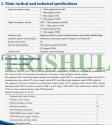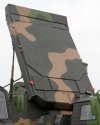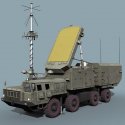Before we go on further, there needs to be some explanation with regards to FCR functions and some differences in the philosophies of SAM systems. The differences of SAM systems makes comparisons between SAM systems moot because you cannot expect to apply the working principle of one SAM system to another when they have different working principles.
in an FCR, it still needs to continuously track and range the target, while the CW beams will light up the target. The search radar searches, acquires, designates the target and then hands over the target to the FCR. The FCR does the rest, which includes continuing to track the target, while the SR continues to search for more targets. Due to the higher frequency and PRF used by the FCR, the tracking resolution is much greater and tighter compared to the SR, whose tracks would be looser.
Now note: for target illumination, the beam must be Continuous Wave Illumination, and cannot be Pulse, while the tracking and ranging has to be pulse or PRF. The circuits are different between the two. You would have to assign some parts of the array as PRF, and some parts to be CWI. With a PESA unit, you would have to literally divide the array between a main section that is PRF, and smaller section that is CWI. In the case of these two radars below, the main radar is PRF, but these small arrays to the side and below are CWI. (MPQ-53 to the left, HT-233 to the right). The PRF ability also gives these radars a search function either to serve as an autonomous unit (MPQ-53) or as a back up if the primary search radar is taken out (HT-233). The main array tracks the target in high PRF, and cues the illuminating arrays to the target.
View attachment 51278 View attachment 51277
But in this next case of the Flaplid, there are no separation.
View attachment 51279
That is because this array also works on FMCW or Frequency Modulated Continuous Wave. Because CW is continuous and has no stops, you cannot get range information. You need stops. What FMCW does is that using frequency modulation, it introduces "chirps" into the CW, and the radar uses the timing of the echoes of these chirps to obtain the range. The FMCW beams is capable of tracking and ranging the target with the same beam that is used to illuminate the target for the missiles.
Flaplid relies on the Big Bird for search information. Flaplid works on X-band only, which is inefficient for search, while Big Beard is S-band. Note that Flaplid is a spaced phase array with the feed on the rear, while Big Bird is a reflective spaced phase array with the feeds on the front.
View attachment 51280
According to CMANO, Type 346 relies on ICWI, or Interrupted Continuous Wave Illumination. ICWI is a subset or kind of FMCW, where you introduce pauses or stops in the CW, which is used for range information. That spins a different explanation of how the Type 346 could illuminate targets using the main array itself, and would not rely on small dedicated CW arrays described on Wiki. To be honest, both systems would work. But if the Chinese were already developing ICWI techniques, they would be nearly doing so at the same time while Thales was working on APAR, which is the first system in the West to use this technique. The other problem of this is that the HQ-9 would have to be modified to accept ICWI instead of just CWI, though this can be done, just as Standards and ESSMs were updated to handle the ICWI of the Thales APAR.
Even if this system works, the whole ship still needs some S-band to serve as the main search radar. The SR and FCR duality remains strong in the PLA.
SPY-1D works a bit differently. SPY-1D is a search radar but also has an engagement mode with higher PRF and frequency modes for tighter tracking. It would have to use the longer spectrum of the S-band for search, and the shorter spectrum for fire control. As the radar steps down from search to engagement, from numerous loosy tracking to designated threat, tighter more accurate tracking, it would turn the SPG-62 illuminators which are entirely dumb, towards the target. Unlike true FCRs, SPG-62 only lights the target, and does not receive echoes and back and processes the information. This is why AEGIS and SPY-1 works differently from other SAM systems, where the FCR is still receiving and processing reflected signals.
In the Wiki explanation of Type 346, the Type 346 would work this way. 346 would step down from search to an engagement mode, go from looser tracking of targets to tighter tracking, and simply directs the dumb CW arrays to the target. For me, that sounds a lot simpler and would not require any modification on the HQ-9 seekers to work with ICWI.
With regards to the shape, the Type 346 is taller than it is wider. Assuming the main array itself is equal length both width and height, that would leave space above and below the main array for small CW arrays. This being a C-band array, each element would be much smaller, and they can operate on peak power right off.
On the Type 346A, the main panel is now perfectly square. This should mean that the main array inside the panel would be equal length in both width and height, but its dimensions expanded to fill the square panel, leaving little room but the corners. At this point, the HQ-9 may have shifted to ARH seekers, about the time the 052D is introduced. The newer HQ-9 with ARH could also work on the Type 052C, though the C-band arrays would no longer function.
The fact both Type 346 and 346A are used in the Chinese carriers as the main search radars, means they should be S-band for that purpose. Being C-band would be detrimental due to the reduced range of this waveband. The C-band on the Liaoning's Type 346 would have to be eliminated, as there is no point in having it, and the radar could have added more S-band elements to improve the search performance.
If you were to use all C-band on the array, that would more than double the number of elements in the array, greatly increase the power used, and with the added complexity of adding an ICWI circuit, also greatly increasing the cost per face, while not increasing the range and may still require a separate search radar altogether. That does not sound logical in the face of a still developing nation and navy budget at that time.













